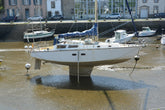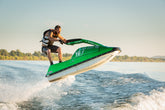Kneeboarding, a thrilling water sport, has been captivating adventurers and adrenaline seekers for decades. This exhilarating activity involves riding a specialized board while being towed by a motorboat, allowing you to glide across the water's surface in a kneeling position. Unlike wakeboarding or water skiing, kneeboarding offers a unique and dynamic experience, combining elements of surfing, wakeboarding, and skateboarding.
As a kneeboarder, you'll find yourself carving through the waves, executing impressive tricks, and experiencing an unparalleled connection with the water. Whether you're a seasoned thrill-seeker or a newcomer to the world of water sports, kneeboarding promises an unforgettable adventure that will test your balance, agility, and determination.
History of kneeboarding
The origins of kneeboarding can be traced back to the 1970s when surfers and water sports enthusiasts sought new ways to ride the waves. Initially, kneeboarding was a simple adaptation of surfing, with riders kneeling on surfboards and being towed behind boats. As the sport gained popularity, specialized kneeboarding equipment was developed, including boards designed specifically for this purpose.
Over the years, kneeboarding has evolved from a niche activity to a globally recognized water sport. Professional competitions and events have emerged, showcasing the incredible skills and athleticism of kneeboarders from around the world. Today, kneeboarding communities can be found in coastal regions and inland lakes, where enthusiasts gather to share their passion and push the boundaries of this exhilarating pursuit.
Benefits of kneeboarding
Kneeboarding offers a multitude of benefits that extend beyond the thrill of the ride. Here are some compelling reasons to embrace this exciting water sport:
- Full-Body Workout: Kneeboarding engages your entire body, providing an intense workout for your core, arms, and legs. The constant balancing and maneuvering required to stay upright and execute tricks will challenge your strength and endurance, leading to improved overall fitness.
- Stress Relief: There's nothing quite like the rush of adrenaline and the freedom of gliding across the water to help you unwind and escape the stresses of daily life. Kneeboarding allows you to immerse yourself in the present moment, offering a refreshing break from the demands of the world.
- Skill Development: Mastering kneeboarding requires dedication, patience, and a willingness to learn. As you progress, you'll develop a keen sense of balance, coordination, and body control, skills that can translate to other areas of your life.
- Bonding Experience: Kneeboarding is often a social activity, providing opportunities to connect with friends, family, and like-minded individuals who share your passion for water sports. Whether you're hitting the water together or sharing stories and tips, the kneeboarding community fosters a sense of camaraderie and lasting friendships.
Essential equipment for kneeboarding
To embark on your kneeboarding journey, you'll need to equip yourself with the proper gear. Here are the essential items every kneeboarder should have:
- Kneeboard: The heart of your setup, a kneeboard is designed with a specialized shape and features to accommodate your kneeling position. Kneeboards come in various sizes and styles, catering to different skill levels and preferences.
- Life Jacket: Safety should always be a top priority when engaging in water sports. A properly fitted life jacket is an absolute must-have, providing buoyancy and peace of mind while you're on the water.
- Tow Rope: A sturdy tow rope is essential for connecting your kneeboard to the tow boat. Look for ropes specifically designed for kneeboarding, as they are built to withstand the forces and dynamics of the sport.
- Helmet: Protecting your head is crucial, especially when attempting advanced tricks or navigating choppy waters. A well-fitted helmet can help prevent serious injuries and give you the confidence to push your limits.
- Gloves: Kneeboarding can be tough on your hands, so investing in a good pair of gloves is highly recommended. Gloves not only provide a better grip but also protect your hands from rope burn and abrasions.
Choosing the right kneeboard
With a wide range of kneeboards available on the market, selecting the right one for your needs can be a daunting task. Here are some key factors to consider when choosing your kneeboard:
- Skill Level: As a beginner, opt for a larger and more stable board to help you develop your balance and confidence. As you progress, you can transition to smaller and more maneuverable boards designed for advanced tricks and higher speeds.
- Weight and Height: Kneeboards are designed to accommodate different weight ranges and rider heights. Ensure that you select a board that is appropriate for your size, as this will directly impact your stability and control on the water.
- Board Construction: Kneeboards can be made from various materials, including foam, wood, and composite materials. Each material offers different characteristics in terms of durability, buoyancy, and performance. Consider your intended use and budget when making your choice.
- Board Shape: The shape of the kneeboard can influence its handling and performance. Wider boards tend to be more stable, while narrower boards offer better maneuverability and responsiveness.
- Fin Setup: Many kneeboards feature fin systems that can be adjusted or customized to suit different riding styles and water conditions. Experiment with different fin configurations to find the setup that works best for you.
Getting started with kneeboarding techniques
Once you've acquired the necessary equipment, it's time to hit the water and start mastering the art of kneeboarding. Here are some essential techniques to get you started:
- Proper Kneeling Position: Maintaining the correct kneeling position is crucial for balance and control. Keep your knees shoulder-width apart, and position your body weight evenly on the board. Lean slightly back, with your arms extended in front of you for stability.
- Deep Water Start: Before attempting to ride, practice deep water starts to get a feel for the board and build confidence. With the board floating in deep water, kneel on it and practice balancing and maneuvering.
- Boat Starts: When you're ready to be towed, communicate clearly with your boat driver and follow their instructions. Start in a kneeling position, holding the tow rope handle firmly. As the boat accelerates, gradually lean back and find your balance.
- Turning: To turn while riding, shift your weight and lean in the desired direction. For sharper turns, apply pressure with your inside knee and arm, while keeping your outside arm extended for counterbalance.
- Edging: Edging involves tilting the kneeboard from side to side, allowing you to carve turns and maintain control at higher speeds. Practice edging in both directions to improve your overall technique.
Basic kneeboarding maneuvers
Once you've mastered the fundamentals, it's time to expand your repertoire with some basic kneeboarding maneuvers. These moves will not only add excitement to your rides but also help you develop the skills necessary for more advanced tricks:
- Surface Turns: Surface turns involve executing tight, controlled turns while riding close to the water's surface. These turns require precise weight distribution and edging techniques.
- Wake Jumps: Crossing the boat's wake at an angle allows you to catch air and perform small jumps. Master the timing and body positioning to land these jumps smoothly and safely.
- Surface Spins: Initiate a spin by shifting your weight and using your arms to rotate your body. Practice spinning in both directions and holding the spin for as long as possible.
- Sliders: A slider is a maneuver where you slide the kneeboard across the water's surface, creating a spray of water. This move requires precise body positioning and can be a precursor to more advanced tricks.
- Endos: An endo, short for "end-over-end," is a maneuver where you lift the nose of the kneeboard and rotate it over your head. This move requires excellent timing and commitment, but it's a crowd-pleaser when executed correctly.
Advanced kneeboarding tricks
As you progress in your kneeboarding journey, you'll be tempted to push the boundaries and attempt more advanced tricks. Here are some thrilling maneuvers that will challenge your skills and add an extra level of excitement to your rides:
- Raleys: A raley is a spectacular trick where you release the tow rope, launch into the air, and land back on the kneeboard. This move requires precise timing, balance, and a fearless attitude.
- Inverts: An invert involves rotating the kneeboard upside down while in the air, essentially riding inverted before landing back on the water. This trick demands exceptional body control and a solid understanding of aerial dynamics.
- Handle Passes: Handle passes involve releasing the tow rope handle, passing it around your body, and catching it again while riding. This trick requires coordination, timing, and a steady hand.
- Tandem Riding: For an added challenge, try tandem riding with a partner. This involves two kneeboarders riding on a single board, coordinating their movements and weight distribution for a truly unique experience.
Safety tips for kneeboarding
While kneeboarding is an exhilarating activity, safety should always be your top priority. Here are some essential safety tips to keep in mind:
- Wear Proper Safety Gear: Never compromise on the quality of your life jacket, helmet, and other protective equipment. Ensure that they fit properly and are in good condition before each session.
- Follow Boating Regulations: Familiarize yourself with local boating regulations and adhere to them at all times. This includes obeying speed limits, respecting designated areas, and being aware of other watercraft.
- Communicate with Your Boat Driver: Establish clear hand signals or verbal commands with your boat driver to ensure smooth and safe operation. Maintain constant communication throughout your session.
- Stay Hydrated and Rested: Kneeboarding can be physically demanding, so it's essential to stay hydrated and well-rested. Avoid riding when you're fatigued or under the influence of substances that may impair your judgment or coordination.
- Know Your Limits: Progression is essential, but it's crucial to know your limits and not attempt tricks or maneuvers that are beyond your current skill level. Build up your abilities gradually and seek guidance from experienced kneeboarders when necessary.
Kneeboarding spots around the world
Kneeboarding enthusiasts are fortunate to have a wide array of stunning locations to explore and enjoy their beloved sport. From pristine lakes to breathtaking coastal regions, these spots offer diverse water conditions and scenic backdrops that will elevate your kneeboarding experience:
- Lake Powell, Utah/Arizona (USA): With its crystal-clear waters and stunning red rock formations, Lake Powell is a true paradise for kneeboarders. The calm waters and picturesque scenery make it a popular destination for water sports enthusiasts.
- Lake Tahoe, California/Nevada (USA): Nestled in the Sierra Nevada mountains, Lake Tahoe boasts pristine waters and stunning vistas. The lake's clear blue waters and surrounding pine forests create a serene and unforgettable kneeboarding environment.
- Great Lakes Region (USA/Canada): The Great Lakes, including Lake Michigan, Lake Erie, and Lake Ontario, offer ample opportunities for kneeboarding. With vast expanses of freshwater and diverse shorelines, these lakes cater to kneeboarders of all skill levels.
- Gold Coast, Queensland (Australia): The Gold Coast is renowned for its exceptional beaches and surf culture, making it a prime kneeboarding destination. The warm waters and consistent waves provide ideal conditions for both beginners and advanced riders.
- Lake Annecy, Haute-Savoie (France): Nestled in the French Alps, Lake Annecy is a picturesque location that combines stunning mountain scenery with crystal-clear waters, perfect for a serene kneeboarding experience.
- Lake Wakatipu, Queenstown (New Zealand): Surrounded by the majestic Southern Alps, Lake Wakatipu offers breathtaking views and calm waters, making it a popular spot for kneeboarders seeking a scenic and tranquil adventure.
- Lake Como, Lombardy (Italy): With its stunning Italian lakeside towns and picturesque mountain backdrops, Lake Como provides a unique and enchanting setting for kneeboarding enthusiasts.
Kneeboarding competitions and events
For those seeking to showcase their skills and compete against fellow kneeboarders, numerous competitions and events are held around the world. These events not only provide a platform for athletes to push their limits but also foster a sense of community and camaraderie within the kneeboarding world:
- World Kneeboarding Championships: Hosted by the International Kneeboarding Association (IKA), the World Kneeboarding Championships is the pinnacle event for professional kneeboarders. It features various categories and attracts top athletes from around the globe.
- National Kneeboarding Championships: Many countries host their own national championships, providing opportunities for local kneeboarders to compete and represent their regions on a national stage.
- Regional Competitions: In addition to national and international events, various regional competitions are held throughout the year, allowing kneeboarders to test their skills and gain valuable experience.
- Kneeboarding Festivals: Combining competition with celebration, kneeboarding festivals offer a unique atmosphere where riders can compete, showcase their talents, and enjoy various activities and entertainment.
- Exhibition Events: Kneeboarding exhibitions and demonstrations are often held at water sports events, providing an opportunity for professionals to showcase their skills and inspire newcomers to the sport.
Resources for learning more about kneeboarding
Continuous learning and skill development are essential for mastering the art of kneeboarding. Fortunately, there are numerous resources available to help you deepen your knowledge and improve your techniques:
- Instructional Videos and Online Tutorials: Countless instructional videos and online tutorials are available, offering step-by-step guidance on various kneeboarding techniques and tricks. These visual resources can be invaluable for both beginners and experienced riders.
- Kneeboarding Clinics and Camps: Attend kneeboarding clinics or camps led by experienced instructors and professionals. These immersive experiences provide hands-on training, personalized feedback, and the opportunity to learn from the best in the sport.
- Kneeboarding Communities and Forums: Join online kneeboarding communities and forums to connect with fellow enthusiasts, share knowledge, and stay up-to-date with the latest trends and developments in the sport.
- Local Kneeboarding Clubs and Organizations: Many areas have local kneeboarding clubs or organizations that offer group rides, events, and opportunities to learn from experienced members.
- Professional Coaching and Private Lessons: For personalized instruction and accelerated progress, consider hiring a professional kneeboarding coach or taking private lessons. Tailored guidance can help you overcome specific challenges and refine your techniques more efficiently.
Conclusion
Kneeboarding is a thrilling and dynamic water sport that offers an unparalleled sense of freedom, excitement, and connection with the water. Whether you're a beginner or an experienced rider, mastering the art of kneeboarding requires dedication, perseverance, and a willingness to continuously learn and improve.
By following the techniques, tips, and safety guidelines outlined in this comprehensive guide, you'll be well-equipped to embark on an exhilarating kneeboarding journey. Remember to start with the fundamentals, gradually progress to more advanced maneuvers, and always prioritize safety.


![Veratron OL 43 Smart Marine Monitoring TFT Display [B00126101]](http://arcmarine.co/cdn/shop/files/111172XL_165x.jpg?v=1763678982)
![Veratron Suzuki VMH-35 PWM Display w/Sumitomo Connectors [B00204101]](http://arcmarine.co/cdn/shop/files/111170XL_165x.jpg?v=1763678982)



